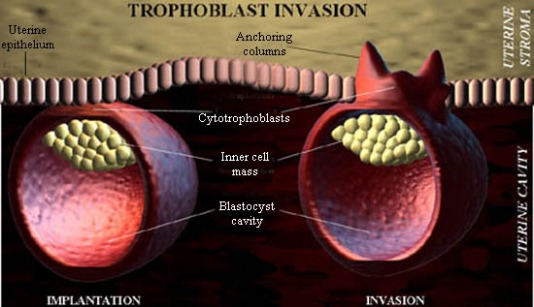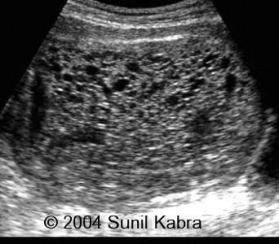This web page was produced as an assignment for Genetics 677, an undergraduate course at UW-Madison.
For microarray evidence on Nanog's link to Gestational Trophoblastic Disease, please click the following link:
Nanog overexpression
When Nanog goes wrong...
Gestational Trophoblastic Disease
The inside story.. When a mother has too much Nanog:

Figure 1: Diagram illustrating trophoblast invasion of the uterus - a biological view of how Gestational Trophoblastic Disease develops.(1)
According to Siu et al (2008), Nanog, an important transcription factor that maintains pluripotency of embryonic stem cells, is found to have significantly increased mRNA and protein levels in placental tissues of patients who have Gestational Trophoblastic Disease. (7) Nanog has also been reported to be involved in other diseases like testicular cancer, breast carcinomas and germ cell tumors. (6)

Who: Women following pregnancy, miscarriage or an abortion
What: A malignant and rapidly invasive cancer in women's uterus
Also known as: Chorioblastoma; Trophoblastic tumor; Choriocarcinoma; Chorioepithelioma; Invasive/malignant mole; Gestational trophoblastic neoplasia
Origin: Tumor development from the trophoblast layer, the outer layer of an embryo (fertilised egg) which develops into the placenta (amnion and chorion) (3)
Figure 2: Ultrasound scan of the classical appearance of Gestational Trophoblastic Disease (2)
Prevalence:
Two common forms of Gestational Trophoblastic Disease (GTD) is reported to be relatively common among women.
Hydatidiform moles (HMs) is reported to affect every 1 out of 2000 pregnant women below 17 or above 35in United States(3). 2 to 3% Hydatidiform moles cases are said to lead to Choriocarcinoma, a more chronic form of GTD and 25% of Choriocarcinoma cases develop after delivery of a normal child (3 and 4).
Symptoms: (3 and 4)
Common tell-tale signs for women who have GTD are irregular vaginal bleeding, severe vomitting, uneven swelling of the uterus, passage of grapelike tissue following pregnancy. During pregnancy, such symptoms may indicate the manifestation of GTD, the lack of fetal movement, absent fetal heartbeats and high levels of Human Chorionic Gonadotropin (HCG).
Figure 3: Cartoon illustrating the difficulties of pregnancy (5)
References:
1. (Figure1) St George's, University of London. Introduction to Reproductive Biology. Retrieved January 30, 2009, from http://www.sgul.ac.uk/depts/immunology/~dash/troph/trophoblast.jpg
2. (Figure 2) SonoWorld (2009) Complete Molar Gestation: Role of Ultrasound. Retrieved January 31, 2009, from http://www.sonoworld.com/Article/ShowArticleImage.aspx?id=9098&Type=Paragraph
3. Merck Manuals, Online Medical Library (Novermber, 2005) Gestational Trophoblastic Disease. Retrieved January 30, 2009, from http://www.merck.com/mmpe/sec18/ch254/ch254f.html
4. Healthline ( September 11, 2006) Gestational Trophoblastic Disease. Retreived January 30, 2009, from http://www.healthline.com/adamcontent/gestational-trophoblastic-disease
5. (Figure 3) Mchumor. Retrieved February 1, 2009, from http://www.pioneer.net/~mchumor/00images/2192_pregnancy_cartoon.gif
6. Science Daily, (November 30, 2005) Study hints at role of stem cell genes in testicular, breast cancers. Retrieved January 24, 2009, http://www.sciencedaily.com/releases/2005/11/051130085332.htm
7. Siu, M. K. Y., Wong, E. S. Y., Chan, H. Y., Ngan, H. Y. S.,Chan, K. Y. K., and Cheung, A. N. Y.(2008) Overexpression of NANOG in Gestational Trophoblastic Diseases. The American Journal for Pathology, 173(4), 1165-1172. DOI: 10.2353/ajpath.2008.080288
Ka Yi, Ling ([email protected])
Page last updated 05/12/09
www.gen677.weebly.com


